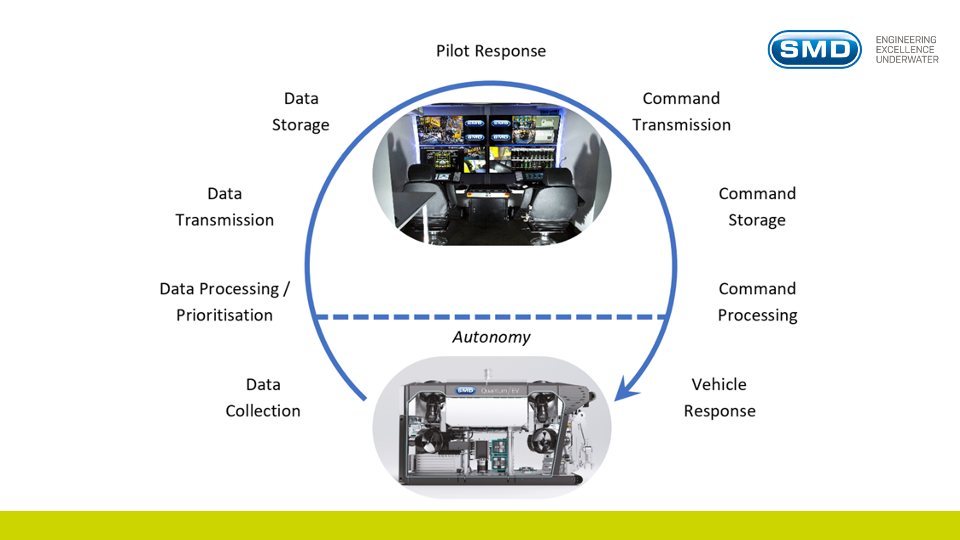SMD
.jpg?width=1024&height=768&name=Andrew%20Ambrose-Thurman%20pic%202%20(1).jpg)
The company
SMD stands as the world’s largest independent designer and manufacturer of specialist subsea ROVs (Remotely Operated Vehicles) with over 50 years of experience in subsea engineering.
With origins as a Newcastle University spin-out, SMD has a history of pioneering achievements, including delivering eight world-first projects, winning five Queen’s awards, and developing the first subsea plough.
Their collaboration with Newcastle University, earning a $200K “Moonshot Award” in the Shell Ocean Discovery XPRIZE competition, underscores their commitment to innovation in the subsea engineering field.
Challenges in offshore wind operations
Offshore wind farms are integral to the renewable energy transition but are expensive to build and maintain. The installation and operation of these wind farms involve high costs, primarily due to the need for on-site teams.
ROV pilots must be present on the ship when flying the ROV. An ROV is a subsea vehicle that can do an inspection or intervention tasks. The vehicle is connected via an umbilical to the ship where data (camera feeds, sensor information) is transferred for the pilot to see. The pilot can then control the movement of the ROV and operate its arms or other instruments.
Personnel working on these projects face health and safety risks, often remaining offshore for extended periods. These traditional methods of operation and maintenance (O&M) in offshore wind farms are expensive, leading to reduced profitability.

The results
Andrew from SMD, responsible for managing the overall project, worked closely with the National Innovation Centre for Data (NICD) to ensure seamless communication and collaboration. Alongside this, a group of software and electronic engineers from SMD were involved in diverse segments of the project, enriching their technical expertise.
Initiation and focus
The project commenced in January 2022, with a primary focus on identifying a suitable IoT real-time data streaming technology that would comply with the strict latency requirements. The Azure IoT Edge suite was selected for building the data streaming solution.
Data analysis and pipeline evaluation
Throughout the project, the team engaged in thorough data analysis to evaluate the performance and efficiency of the end-to-end data streaming pipeline, such as evaluating message round trip times, edge to cloud latency, and network recovery times.
System design and development
A major achievement was the design and development of a real-time data streaming system and simulators to run controlled experiments with focus on data prioritisation under bandwidth constrained scenarios. This system was crucial in facilitating the subsequent phases of the project.
Prototype development
SMD's team successfully developed a prototype for the data streaming pipeline, showcasing their capability to innovate and adapt to complex technological demands.
Testing under constraints
The prototype of the data streaming platform was tested under bandwidth constraints simulating the real-world deployment as closely as possible.
Project completion and achievements
By May 2023, the collaboration phase with the National Innovation Centre for Data (NICD) concluded. By this time SMD had made significant progress, achieving a level of development that enabled data streaming from a remotely operated ROV through the cloud to a control room and efficient data acquisition.

Data science tools and techniques
The National Innovation Centre for Data (NICD) supported the design and implementation of a real-time IoT data streaming system with a local time-series database solution. The ability to set individual data channel priorities was tested under a comprehensive set of bandwidth-constrained and network disconnection experiments, where the monitoring data was collected, visualised, and evaluated using standard data science techniques.
A notable discovery was the behaviour of Azure IoT Edge’s internal module (Edge Hub) concerning data prioritisation post-network disconnection, leading to discussions with Microsoft architects for resolution.
The project successfully delivered a code base for the Azure IoT Edge implementation, written in Python and C, and a report outlining bandwidth constraint experiments with analysis on how the system responded.
Business impact
The collaboration between the National Innovation Centre for Data (NICD) and SMD marked a significant evolution for SMD, assisting with the transitioning from a manufacturer of robust, reliable vehicles to an innovator of cloud-based control systems. This advancement is a vital step in realising SMD's vision of remotely piloted subsea vehicles, enhancing operational efficiency and safety in subsea activities.
Andrew Ambrose-Thurman, Lead Engineer (Autonomous Systems) at SMD, reflects on this transformation: "Traditionally, our business model involved manufacturing the vehicle and concluding the transaction with the sale. Our latest advancements, however, are steering us towards a servitisation model, allowing us to offer our products and services on a subscription basis so our customers get the functionality they want at the times they need it."
This shift not only presents new opportunities for advanced data analysis but also positions SMD to effectively meet evolving market needs. The collaboration has enabled SMD to offer clients enhanced operational efficiency, safety, and cost savings, in line with the industry's shift towards reduced offshore workforce and increased automation.
Andrew Ambrose-Thurman further adds, "It's the clever part that we're really starting to push for. There is a lot of work across the business endeavouring to make our vehicles smarter. The Horizon project is very much at the forefront of that effort."
Reasons for working with National Innovation Centre for Data
The partnership with the National Innovation Centre for Data (NICD) was driven by several factors:
"All of the people we interacted with were very knowledgeable, and either knew the answers or could research them" says Andrew, highlighting National Innovation Centre for Data's expertise in data science and their ability to tackle unfamiliar problems.
The partnership was enhanced through efficient project management, involving weekly meetings and a shared GitHub repository for streamlined communication and project development.
National Innovation Centre for Data's location in the North East facilitated direct site visits, enabling close observation of project objectives and progress.
The collaboration led to significant knowledge transfer, particularly in cloud systems and real-time data streaming systems. "They equipped us with the skills and training to independently manage similar tasks in the future," Andrew notes, underscoring the National Innovation Centre for Data’s role in fostering SMD's growth and innovation.
"As a collaborative project, it worked really well. The harmonious collaboration between our team and the National Innovation Centre for Data's experts was instrumental in driving the project forward."
Andrew Ambrose-Thurman, Lead Engineer (Autonomous Systems), SMD
With thanks to the North of Tyne Combined Authority Digital Growth and Innovation Programme (NTCA Digital) for funding this project.
To find out more about SMD, visit their website.
You can read more of our case studies and sign up to our newsletter to keep up to date with our latest news, events and developments.

Our Discovery workshop
Our Discovery workshops enable you to explore the potential of your data and understand the benefit you could gain before committing to a full-scale project.